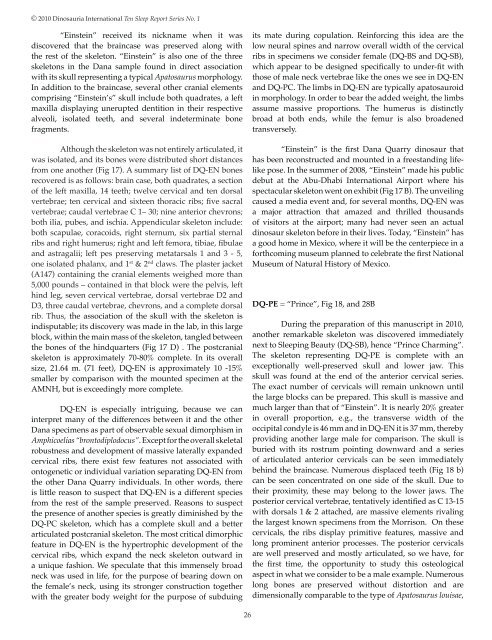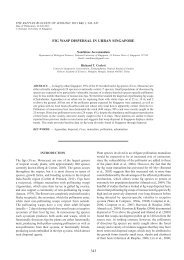1O257LF
1O257LF
1O257LF
You also want an ePaper? Increase the reach of your titles
YUMPU automatically turns print PDFs into web optimized ePapers that Google loves.
© 2010 Dinosauria International Ten Sleep Report Series No. 1<br />
“Einstein” received its nickname when it was<br />
discovered that the braincase was preserved along with<br />
the rest of the skeleton. “Einstein” is also one of the three<br />
skeletons in the Dana sample found in direct association<br />
with its skull representing a typical Apatosaurus morphology.<br />
In addition to the braincase, several other cranial elements<br />
comprising “Einstein’s” skull include both quadrates, a left<br />
maxilla displaying unerupted dentition in their respective<br />
alveoli, isolated teeth, and several indeterminate bone<br />
fragments.<br />
Although the skeleton was not entirely articulated, it<br />
was isolated, and its bones were distributed short distances<br />
from one another (Fig 17). A summary list of DQ-EN bones<br />
recovered is as follows: brain case, both quadrates, a section<br />
of the left maxilla, 14 teeth; twelve cervical and ten dorsal<br />
vertebrae; ten cervical and sixteen thoracic ribs; five sacral<br />
vertebrae; caudal vertebrae C 1– 30; nine anterior chevrons;<br />
both ilia, pubes, and ischia. Appendicular skeleton include:<br />
both scapulae, coracoids, right sternum, six partial sternal<br />
ribs and right humerus; right and left femora, tibiae, fibulae<br />
and astragalii; left pes preserving metatarsals 1 and 3 - 5,<br />
one isolated phalanx, and 1 st & 2 nd claws. The plaster jacket<br />
(A147) containing the cranial elements weighed more than<br />
5,000 pounds – contained in that block were the pelvis, left<br />
hind leg, seven cervical vertebrae, dorsal vertebrae D2 and<br />
D3, three caudal vertebrae, chevrons, and a complete dorsal<br />
rib. Thus, the association of the skull with the skeleton is<br />
indisputable; its discovery was made in the lab, in this large<br />
block, within the main mass of the skeleton, tangled between<br />
the bones of the hindquarters (Fig 17 D) . The postcranial<br />
skeleton is approximately 70-80% complete. In its overall<br />
size, 21.64 m. (71 feet), DQ-EN is approximately 10 -15%<br />
smaller by comparison with the mounted specimen at the<br />
AMNH, but is exceedingly more complete.<br />
DQ-EN is especially intriguing, because we can<br />
interpret many of the differences between it and the other<br />
Dana specimens as part of observable sexual dimorphism in<br />
Amphicoelias “brontodiplodocus”. Except for the overall skeletal<br />
robustness and development of massive laterally expanded<br />
cervical ribs, there exist few features not associated with<br />
ontogenetic or individual variation separating DQ-EN from<br />
the other Dana Quarry individuals. In other words, there<br />
is little reason to suspect that DQ-EN is a different species<br />
from the rest of the sample preserved. Reasons to suspect<br />
the presence of another species is greatly diminished by the<br />
DQ-PC skeleton, which has a complete skull and a better<br />
articulated postcranial skeleton. The most critical dimorphic<br />
feature in DQ-EN is the hypertrophic development of the<br />
cervical ribs, which expand the neck skeleton outward in<br />
a unique fashion. We speculate that this immensely broad<br />
neck was used in life, for the purpose of bearing down on<br />
the female’s neck, using its stronger construction together<br />
with the greater body weight for the purpose of subduing<br />
its mate during copulation. Reinforcing this idea are the<br />
low neural spines and narrow overall width of the cervical<br />
ribs in specimens we consider female (DQ-BS and DQ-SB),<br />
which appear to be designed specifically to under-fit with<br />
those of male neck vertebrae like the ones we see in DQ-EN<br />
and DQ-PC. The limbs in DQ-EN are typically apatosauroid<br />
in morphology. In order to bear the added weight, the limbs<br />
assume massive proportions. The humerus is distinctly<br />
broad at both ends, while the femur is also broadened<br />
transversely.<br />
“Einstein” is the first Dana Quarry dinosaur that<br />
has been reconstructed and mounted in a freestanding lifelike<br />
pose. In the summer of 2008, “Einstein” made his public<br />
debut at the Abu-Dhabi International Airport where his<br />
spectacular skeleton went on exhibit (Fig 17 B). The unveiling<br />
caused a media event and, for several months, DQ-EN was<br />
a major attraction that amazed and thrilled thousands<br />
of visitors at the airport; many had never seen an actual<br />
dinosaur skeleton before in their lives. Today, “Einstein” has<br />
a good home in Mexico, where it will be the centerpiece in a<br />
forthcoming museum planned to celebrate the first National<br />
Museum of Natural History of Mexico.<br />
DQ-PE = “Prince”, Fig 18, and 28B<br />
During the preparation of this manuscript in 2010,<br />
another remarkable skeleton was discovered immediately<br />
next to Sleeping Beauty (DQ-SB), hence “Prince Charming”.<br />
The skeleton representing DQ-PE is complete with an<br />
exceptionally well-preserved skull and lower jaw. This<br />
skull was found at the end of the anterior cervical series.<br />
The exact number of cervicals will remain unknown until<br />
the large blocks can be prepared. This skull is massive and<br />
much larger than that of “Einstein”. It is nearly 20% greater<br />
in overall proportion, e.g., the transverse width of the<br />
occipital condyle is 46 mm and in DQ-EN it is 37 mm, thereby<br />
providing another large male for comparison. The skull is<br />
buried with its rostrum pointing downward and a series<br />
of articulated anterior cervicals can be seen immediately<br />
behind the braincase. Numerous displaced teeth (Fig 18 b)<br />
can be seen concentrated on one side of the skull. Due to<br />
their proximity, these may belong to the lower jaws. The<br />
posterior cervical vertebrae, tentatively identified as C 13-15<br />
with dorsals 1 & 2 attached, are massive elements rivaling<br />
the largest known specimens from the Morrison. On these<br />
cervicals, the ribs display primitive features, massive and<br />
long prominent anterior processes. The posterior cervicals<br />
are well preserved and mostly articulated, so we have, for<br />
the first time, the opportunity to study this osteological<br />
aspect in what we consider to be a male example. Numerous<br />
long bones are preserved without distortion and are<br />
dimensionally comparable to the type of Apatosaurus louisae,<br />
26



